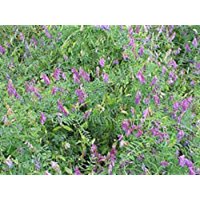Recently, the question came up from a couple of clients and information seekers about what to plant in summer food plots now that its hot and too late for clover. Although the past couple weeks have been great for clover or just about anything you want to grow with consistent rain events and cool temps, this time of year is very risky to try and grow clover. The little tender plants once sprouted cannot survive dry soil until their roots are a couple of inches into the ground. Best to wait until fall to plant clover. But what to do in the meantime?
Let’ say you just finished clearing a new food plot out of the forest or have a log landing you want to establish in a nice food plot. Once you have your soil pH addressed, you may want to plant Buckwheat. Buckwheat is quick to establish and grow once there is adequate soil moisture, will grow in poor soil, will surpass weeds and suppress them from establishing themselves, help with soil aggregation (making it loose), fixes Nitrogen (one of the grain plants that will do so) and is good at scavenging nutrients like Phosphorous and Calcium from the soil. When there is very little topsoil and organic mater, it will build up an organic layer by providing a green manure biomass that can help build soil as it decomposes.
Buckwheat will flower in a month once it starts growing – great for honeybees and other pollinators. It can be cut then or you can let it go to seed in 45 days and provide seeds for turkeys to eat. These seeds will germinate next spring your you can disk your stand in and let it come back up for an early fall green forage.
Along with your buckwheat plant some Crimson Clover. Crimson Clover can fix 100lb. of Nitrogen per acre from the air and provide 1,500 lbs. of forage per acre and many tons of biomass for weed suppression and green manure. It will grow in a wide variety of soils and can be planted up until mid-August and provide a winter-hardy forage. Deer will dig down through the snow to get at it. But it is not a favorite clover in the summer if other forage is available.
A mixture of 25lbs Buckwheat and 1lbs Crimson Clover should provide an good stand. Disk the Buckwheat in very lightly and put the clover on top of the disked ground. A seed drill or even a Plotmaster would do a nice job of planting this mixture.
In spring, the plants will grow from seed again and provide early spring greenup forage. Once conditions are right for planting your soybeans, spray it to kill it off and drill your beans through the residue. Now you can start your double-cropping system that I wrote about with beans in summer and brassicas and winter – hardy cereal grain to get through the winter. Triticale, Spelt, Winter Wheat, Rye are good choices for early summer food plots. Forage oats are good but will freeze out when it gets really cold.
Here’s a photo of a Buckwheat/CC planting with the clover in full bloom.

Another choice you may want to go with is Hairy Vetch. It is winter hardy throughout Pennsylvania and will survive winter if planted by Mid-August. There is a Madison Variety that is more cold hardy but it may be hard to find. Its not highly preferred by deer but what they eat depends on availability of other, more preferred browse. This is a hardy plant in summer food plots.
This plant also fixes Nitrogen and suppresses weeds and contributes 100lbs of Nitrogen to the soil per acre.
Mixed with winter-hardy cereal grain, both will survive the winter and grow in early spring. They can be left to grow into summer then converted to a clover/chicory plot in the fall by burning down the field and overseeding, or spray and plant soybeans into the residue for a summer annual.
If its really late in summer, plant it with Kale and other brassicas for your fall/winter forage.
You should terminate your vetch stand in late May and drill in your beans or corn. Waiting until late spring will provide early forage and also add much more nitrogen to the soil, enough to meet half the needs of the Corn or Sorghum, if that’s what you choose to plant. Use Glyphosate or 2-4,D to burn down and you can disk the residue to increase breakdown and thus more nutrients and drill in your annual. Do not disk deep – we are going no-till, remember.
Here’s a picture of Hairy Vetch.

Once, I had a total failure due to drought of a food plot I planted to clover. A local Amish guy told me to try sorghum sudan. This is a tall sorghum and it can be planted deep – down where the moisture is and make up out of the ground. I set the seed drill to 1.5″ and planted some. It came up and grew to seed head by fall. Deer were bedding in it and standing on hind legs to eat the seed heads. I highly recommend this plant for visual blocking, food and cover.
Summer food plots can be challenging, but planting species that are tolerant of heat and dry weather is the key.
For more information on food plots check out my youtube channel and other blog articles on my website.

